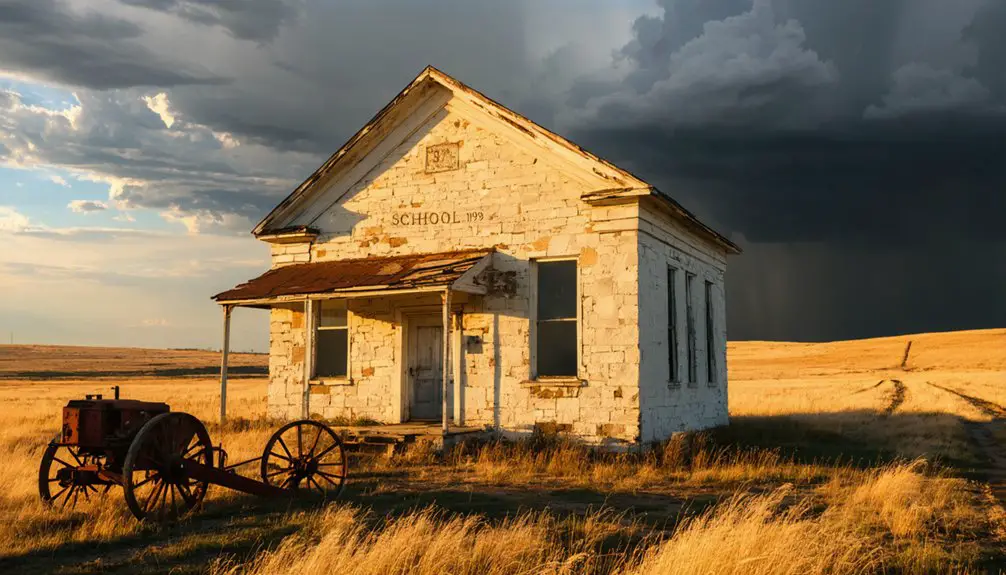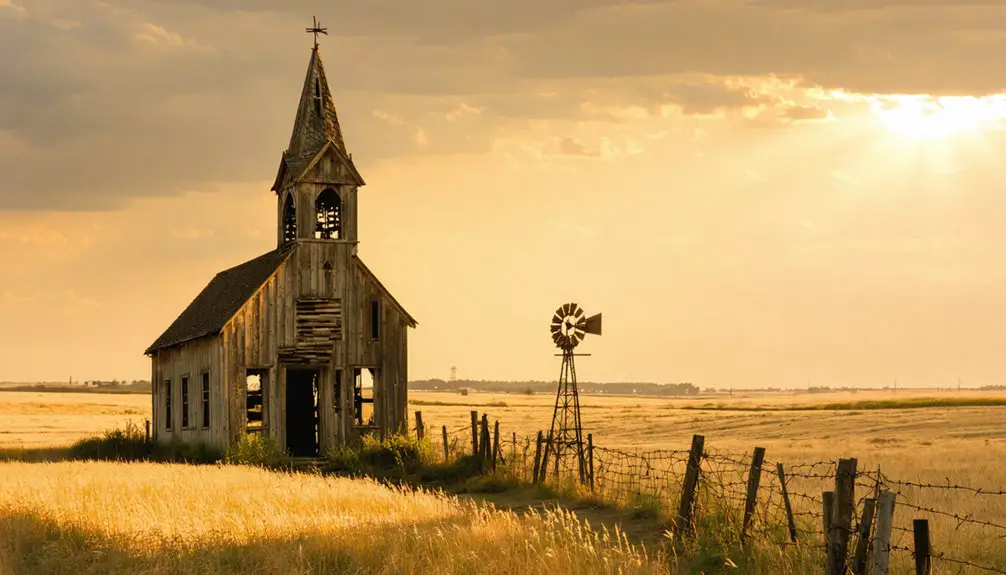You’ll find Hess, Kansas as a haunting reminder of America’s westward expansion, marked by its abandoned church and pioneer cemetery from the 1860s. The town emerged during the post-Civil War railroad boom near Buffalo Bill Cody’s settlement of Rome. While drought and bypassed rail lines ultimately led to its decline, Hess’s remaining structures tell stories of hardy settlers, local grain mills, and the challenging Plains life. The town’s preserved landmarks hold deeper tales of frontier dreams and survival.
Key Takeaways
- Hess was established in 1867 during westward expansion, initially thriving due to Kansas Pacific Railway and military presence nearby.
- The town featured essential services like the Farmers State Bank and general store before economic decline led to closures.
- Economic isolation occurred when rail lines bypassed Hess, while industrial farming practices absorbed small family farms.
- A historic church and cemetery complex remain as primary landmarks, with the church building dating back to 1947.
- The town’s population dwindled as younger residents migrated to urban areas, leading to closure of essential services.
The Rise and Settlement of Hess
As the post-Civil War era ushered in rapid westward expansion, settlement activity in Ellis County, Kansas began around 1867, driven by the extension of the Kansas Pacific Railway and the relocation of military forces.
Buffalo Bill Cody helped establish Rome as one of the first settlements in the area.
You’ll find that railroad expansion brought an influx of workers, soldiers, and opportunists to the area, with Rome emerging as an early boomtown near the future Hess site. Much like its namesake city that was established as a major human settlement for over three millennia, the Kansas town of Rome represented pioneering ambitions in the American West.
The region’s strategic location attracted buffalo hunters and traders, while water-powered grain mills supported Fort Hays operations.
Daily Life in Early Hess Community
Life in early Hess stood in stark contrast to the bustling railway activity that first drew settlers to Ellis County. You’d find yourself rising before dawn to tackle demanding farming routines – tending livestock, maintaining equipment, and working the harsh Kansas soil.
With homes scattered across the landscape, you’d rarely see your neighbors except during occasional social gatherings at makeshift community buildings. The local general store and Farmers State Bank provided essential services until the drought forced many businesses to close. Like the settlers of Buckskin Joe, the population dwindled as resources became scarce.
Isolated farmsteads dotted the prairie, with neighbors meeting only sporadically at simple gathering places built by the community.
You’d have to be resourceful to survive, relying on what you could grow, build, or repair yourself. Your children would split their time between farm chores and basic schooling in multi-purpose structures, while health care meant depending on home remedies.
Living in Hess meant adapting to isolation, weathering environmental challenges, and forming alliances with neighboring families for mutual support during difficult times.
Economic Forces Behind the Town’s Decline
While Hess initially thrived on its connection to regional transportation networks, the town’s decline accelerated when essential rail lines bypassed the settlement in favor of larger urban centers.
You’ll find this economic isolation hit particularly hard as farmers struggled to transport their goods to market efficiently.
The town’s dependence on agriculture proved fatal as industrial farming transformed the region.
Larger mechanized operations absorbed small family farms, triggering widespread agricultural decline.
You’d see fewer workers needed in the fields, prompting younger residents to seek opportunities in growing cities.
Local businesses couldn’t survive as their customer base dwindled.
The population halved like many Kansas towns such as Coldwater, Protection, and Ashland since the 1930s.
The closure of essential services like grocery stores and hardware shops created a downward spiral, leaving Hess unable to compete with nearby urban centers that offered more diverse economic prospects.
The post office closure in the mid-20th century marked another devastating blow to the community’s infrastructure.
Notable Buildings and Landmarks
Standing as a symbol to Hess’s history, the town’s church and cemetery complex remains one of the most significant landmarks you’ll find in this Kansas ghost town. The church architecture dates back to at least 1947, and while it’s now locked and gated, it represents one of the oldest surviving structures in the area.
The cemetery symbolism is particularly poignant, with headstones ranging from simple markers to elaborate monuments that tell the stories of the town’s earliest settlers. Much like the Valleybrook cemetery that holds headstones from 1880, these markers provide valuable insights into the community’s past.
From modest stones to ornate memorials, each marker in Hess Cemetery whispers the tales of pioneers who built this town.
You’ll discover traces of Hess’s railroad heritage nearby, with remnants of tracks that once connected this rural community to the wider world.
While most residential buildings have succumbed to time, you can still spot a few agricultural structures and storage facilities that hint at the town’s former liveliness. Similar to the local Death ground merchandise, visitors can find unique souvenirs that commemorate the town’s history.
Preserving Hess’s Historical Legacy

Despite the challenges of preserving a ghost town, dedicated historical societies have launched extensive efforts to protect Hess’s remaining structures and cultural heritage. Through community engagement, local organizations work to stabilize buildings, document historical artifacts, and maintain the town’s connection to Kansas’s railway history. Similar to the Port Landis settlement that dissolved into nearby towns in 1879, Hess faced economic hardships that led to its decline.
Key preservation initiatives include:
- Converting preserved structures into functional spaces like art galleries and educational centers
- Collecting oral histories and archival materials to document the town’s development
- Creating digital archives and interpretive displays for visitors
You’ll find ongoing restoration projects focused on the town’s public buildings, while researchers compile maps, photographs, and personal accounts. Similar restoration success can be seen in nearby Volland, where a two-story brick building from 1913 has been carefully preserved.
Though funding remains limited, preservation teams continue adapting historical structures to modern uses while maintaining their authentic character, ensuring Hess’s story endures for future generations.
Frequently Asked Questions
What Indigenous Tribes Originally Inhabited the Land Where Hess Was Established?
You’ll find that Plains Native tribes of historical significance – primarily the Cheyenne, Arapaho, and Sioux – originally inhabited this land, using the Smoky Hill River region for seasonal hunting grounds.
Were There Any Major Crimes or Notable Legal Cases in Hess?
Among countless ghost towns documented in Kansas, you won’t find any major crime history or legal disputes recorded in Hess. The town’s small size and agricultural focus kept lawlessness minimal.
What Impact Did Weather Disasters Have on Hess’s Development?
You’ll find the town’s decline was heavily influenced by severe weather events, including drought effects that devastated crops and flood damage that destroyed essential infrastructure, forcing many settlers to abandon their homesteads.
Did Any Famous People Ever Visit or Stay in Hess?
You won’t find any records of famous visitors or celebrity sightings in Hess. Like tumbleweeds blowing through an empty prairie town, documented proof of notable figures passing through doesn’t exist.
What Local Legends or Ghost Stories Are Associated With Hess?
You won’t find documented haunted locations or ghostly encounters in Hess. Historical records focus solely on its role as a cattle shipping point, with no supernatural tales preserved in local folklore.
References
- https://digging-history.com/2015/04/01/ghost-town-wednesday-rome-kansas/
- https://www.youtube.com/watch?v=pswKzYG-C-w
- https://dianastaresinicdeane.wordpress.com/2012/01/29/columbia-a-kansas-ghost-town-story/
- https://legendsofkansas.com/kansas-ghost-town-list/
- https://freepages.rootsweb.com/~gtusa/history/usa/ks.htm
- https://en.wikipedia.org/wiki/Rome
- https://fhsuguides.fhsu.edu/kansasheritage/elliscounty
- https://legendsofkansas.com/densmore-kansas/
- https://www.youtube.com/watch?v=2sIM72082jc
- https://www.indydailyreporter.com/news/ghost-town-lehunt-history-and-local-legend



